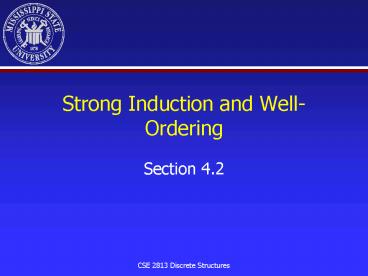Strong Induction and WellOrdering - PowerPoint PPT Presentation
1 / 9
Title:
Strong Induction and WellOrdering
Description:
... axiom about the set of integers called the Well-Ordering Property ... By the well-ordering property, S has a least element, which will be denoted by m. ... – PowerPoint PPT presentation
Number of Views:128
Avg rating:3.0/5.0
Title: Strong Induction and WellOrdering
1
Strong Induction and Well-Ordering
- Section 4.2
2
Mathematical Induction (Recap)
- A proof by mathematical induction that P(n) is
true for every positive integer n consists of two
steps - Basis step The proposition P(1) is shown to be
true. - Inductive step The implication P(k)?P(k1) is
shown to be true for every positive integer k.
3
Examples
- Use mathematical induction to prove that n lt 2n
for all positive integers n. - Use mathematical induction to prove that n3n is
divisible by 3 whenever n is a positive integer.
4
Well-Ordered Sets
- The validity of mathematical induction follows
from a fundamental axiom about the set of
integers called the Well-Ordering Property - Every nonempty set of nonnegative integers has a
least element
5
Why Mathematical Induction Is Valid
- Suppose we know that P(1) is true and that the
proposition P(k)?P(k1) is true for all positive
integers k. - To show that P(n) must be true for all positive
integers, assume that there is at least one
positive integer for which P(n) is false. - Then the set S of positive integers for which
P(n) is false is nonempty.
6
Why MathematicalInduction Is Valid (Cont..)
- By the well-ordering property, S has a least
element, which will be denoted by m. We know that
m cannot be 1, since P(1) is true. - Since m gt 1, m-1 is a positive integer.
- Furthermore, since m-1 is less than m, it is not
in S, so P(m-1) must be true.
7
Why MathematicalInduction Is Valid (Cont..)
- Since the implication P(m-1) ? P(m) is also true,
it must be the case that P(m) is true. - This contradicts the choice of m.
- Hence, P(n) must be true for every positive
integer n.
8
Strong Induction
- To prove that P(n) is true for every positive
integer n consists of two steps - Basis step The proposition P(1) is shown to be
true. - Inductive step The implication P(1)?P(2)?
?P(k)?P(k1) is shown to be true for every
positive integer k.
9
Example
- Use Strong induction to show that if you can run
one mile or two miles, and if you can always run
two more miles once you have run a specified
number of miles, then you can run any number of
miles. - Show that if n is an integer greater than 1, then
n can be written as the product of primes.































